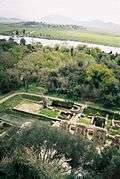Butrint
Butrint (Latin: Buthrōtum; from Ancient Greek: Βουθρωτόν and Βουθρωτός[2], romanized: Bouthrōtón) was an ancient Greek and later Roman city and bishopric in Epirus.[3][4][5] Perhaps inhabited since prehistoric times, Buthrotum was a city of the Epirote tribe of the Chaonians, later a Roman colony and a bishopric. It entered into decline in Late Antiquity, before being abandoned during the Middle Ages after a major earthquake flooded most of the city. In modern times it is an archeological site in Vlorë County, Albania, some 14 kilometres south of Sarandë and close to the Greek border. It is located on a hill overlooking the Vivari Channel and is part of the Butrint National Park. Today Bouthrotum is a Latin Catholic titular see and also features the Ali Pasha Castle.
Butrint (in Albanian) Boυθρωτόν Bouthroton (in Greek) Buthrotum (in Latin) | |
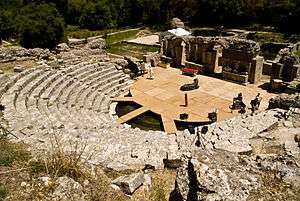 Theatre of Buthrotum | |
 Location in Albania | |
| Location | Vlorë County, Albania |
|---|---|
| Region | Chaonia |
| Coordinates | 39°44′44″N 20°1′14″E |
| Type | Settlement |
| History | |
| Periods | Antiquity and Middle Ages |
| Site notes | |
| Archaeologists | Luigi Maria Ugolini and Hasan Ceka |
| Public access | yes |
| Criteria | Cultural: iii |
| Reference | 570 |
| Inscription | 1992 (16th session) |
| Extensions | 1999 |
| Endangered | 1997 to 2005 |
| Official name | Butrint |
| Designated | 28 March 2003 |
| Reference no. | 1290[1] |
The city is considered as one of the most important archaeological sites in Albania. On the strength of the immense wealth of cultural, historical and natural value with a considerable history, Butrint was declared a UNESCO World Heritage site in 1992 and further a National Park in 2000.[6][7]
History
Ancient Greek period

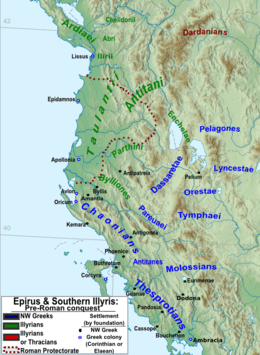
Bouthroton (modern day Butrint) was originally one of the major centres of the Epirote tribe of the Chaonians,[8] part of the northwestern Greek group of tribes.[9] They had close contacts to the Corinthian colony of Corcyra (modern Corfu). According to the Roman writer Virgil, its legendary founder was the seer Helenus, a son of king Priam of Troy, who had moved West after the fall of Troy with Neoptolemus and his concubine Andromache. Both Virgil and the Greek historian Dionysius of Halicarnassus recorded that Aeneas visited Bouthroton after his own escape from the destruction of Troy.
The earliest archaeological evidence of settled occupation dates to between 10th and 8th centuries BC, although some claim that there is earlier evidence of habitation dating from the 12th century BC.[10]
Excavation at Bouthroton has yielded Proto-Corinthian pottery of the 7th century and then Corinthian and Attic pottery of the 6th century, however there are no indications of a prehistoric settlement.[11] Bouthroton was in a strategically important position due its access to the Straits of Corfu, and its location at the crossroads of mainland Greece and Magna Graecia, the Greek and the "barbarian" worlds.[12] Thus, it became one of the two ancient ports in lower Chaonia, the other being Onchesmos (modern Sarandë).[13]
The acropolis was erected on a hill on the bank of a lake Butrint (or lake Bouthrotum). The first extension of the 7th century BC acropolis occurred during the 5th century BC.[14] During the first years of the second Peloponnesian War (413-404 BC) the Corkyreans built fortifications stretching from Ksamil to Buthrotum. Buthrotum being previously an independent city, became subject to nearby Corfu.[15]
By the 4th century BC it had grown in importance and included a theatre, a sanctuary dedicated to Asclepius and an agora. The acropolis of Bouthrotum was protected by three circuit walls. The last and outer wall was erected around 380 BC enclosing and area of 4ha. This 870m-long wall included bastions and five gates.[16] Two of the most important gates were known as Scean and Lion gate.[17] Moreover, the agora, the stoas, the residential zone and the theatre were located in a separate walled area.[14]
Several inscriptions in Buthrotum describe the organization of the Chaonians in the beginning of the 3rd cent. BC. which show that they too had an annual leader called Prostates (Greek: Προστάτης Protector).[9] The Greek calendar of Bouthroton appears in the oldest known computer, the so-called Antikythera Mechanism (c. 150 to 100 BC).[18][19]
The theatre is known for the impressive number of inscriptions carved on its stones. Most of them deal with manumissions and give a great amount of details on the city during the Hellenistic era.[20] The names of those slaves were almost exclusively Greek with a few exception of Latin ones which bore Greek family names.[21]
In 228 BC Buthrotum became a Roman protectorate alongside Corfu. In the middle of the second century BC Buthrotum was the centre of an independent state, possibly the "Koinon of the Prasaiboi", as listed in the list of the theorodokoi at the Oracle of Delphi.[22]
Ancient Roman period
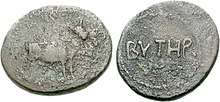
In the next century, it became a part of a province of Macedonia. In 44 BC, Caesar designated Buthrotum as a colony to reward soldiers who had fought for him against Pompey. Local landholder Titus Pomponius Atticus objected to his correspondent Cicero who lobbied against the plan in the Senate. As a result, only small numbers of colonists were settled.
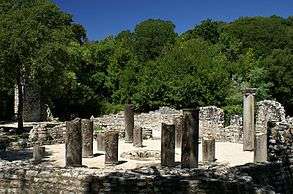
In 31 BC, Roman Emperor Augustus fresh from his victory over Mark Antony and Cleopatra at the battle of Actium renewed the plan to make Buthrotum a veterans' colony. New residents expanded the city and the construction included an aqueduct, a Roman bath, houses, a forum complex and a nymphaeum. During that era the size of the town was doubled.[24] A number of new structures were built next to the existing ones especially around the theatre and the temple of Asklepeios.[25]
In the 3rd century AD, an earthquake destroyed a large part of the town, levelling buildings in the suburbs on the Vrina Plain and in the forum of the city centre. Excavations have revealed that city had already been in decline. However, the settlement survived into the late antique era, becoming a major port in the province of Old Epirus. The town of late antiquity included the grand Triconch Palace, the house of a major local notable that was built around 425.
Byzantine and Slavic period
The walls of the city were extensively rebuilt, most probably at the end of the 5th century, perhaps by Byzantine Emperor Anastasius. The Ostrogoths under Indulf raided the Ionian coast in 550 and may have attacked Buthrotum. In the end of 6th century groups of Slavs possibly arrived at Buthrotum.[26] Evidence from the excavations shows that importation of commodities, wine and oil from the Eastern Mediterranean continued into the early years of the 7th century when the early Byzantine Empire lost these provinces. During the period of Slavic invasions and population movements in the wider region Butrotum was one of the few cities in Epirus that survived and retained its status as a seat of a bishopric without interruption.[27] Because of the scarcity of sources, it is difficult to assess whether Buthrotum was controlled by Slavs or Byzantines between the 7th to 10th centuries.[28]

The Grand Basilica of Buthrotum was built during the first half of the 6th century on the northeast side of the settlement.[29] Other monuments include the Acropolic Basilica (4th century), the Triconch Palace (6th century), the Baptistery with a large, complex mosaic (6th century), the Lake Gate church (9th century) and the Baptistery church (9th century).[30] Arab traveller Muhammad al-Idrisi noted in the 12th century that Buthrotum is a densely populated city with a number of markets.[31]
It remained an outpost of the Byzantine empire fending off assaults from the Normans until 1204 when following the Fourth Crusade, the Byzantine Empire fragmented, Buthrotum falling to the breakaway Despotate of Epirus. In the following centuries, the area was a site of conflict between the Byzantines, the Angevins of southern Italy, and the Venetians.
Between Angevins, Byzantine Empire and Despotate of Epirus
The fortifications were probably strengthened by Byzantine Emperor Michael I.[32]
In 1267, Charles of Anjou took control of both Buthrotum and Corfu, leading to further restorations of the walls and the Grand Basilica. In 1274, Byzantine forces re-entered Buthrotum, an act which caused conflict between the Byzantines and the Despotate of Epirus, because Despot Nikephoros considered the site to be his domain.[33] Despite deep religious differences between the Catholic Charles of Anjou and the staunchly Orthodox Nikephoros, the two allied against Byzantine Emperor Michael, and together drove the Byzantines from the area in 1278.[33] Then, pressed by Charles, Nikephoros ultimately ended up recognizing Charles' rights to all the town that Michael II had awarded to Manfred of Hohenstaufen as part of his wife Helen's dowr, as Charles was his successor, thus ceding to him Buthrotum as well as the entire Acroceraunian Coast from Vlora to Buthrotum.[33]
As part of the Angevin Regnum Albaniae
Buthrotum remained under Angevin rule until 1386, with only two other interruptions: in 1306, and in 1313–1331.[34] In 1305-1306 it was controlled by the Despot of Epirus, Thomas I Komnenos Doukas.[35] Buthrotum became Catholic after it was conquered by the Angevins, and remained so throughout the fourteenth century.[34]
Hodges argues that the "episodic" defensive investment in Buthrotum as a town during this period demonstrates that it still possessed an active urban population, although not one urban dwelling had been identified at the time of writing. Hodges argues this indicates that dwellings were concentrated on the slopes of the northern citadel. The Orthodox Bishopric was transferred to nearby Glyki in 1337 or 1338. The town was reduced in size during the end of the 14th century, due to the tumultuous unrest in the region.[36]
Between Venice and the Ottoman Empire
The dogal Republic of Venice purchased the area including Corfu from the Angevins in 1386; however, the Venetian merchants were principally interested in Corfu and Buthrotum once again declined.
._Venetian_enclave_facing_Corfu..jpg)
By 1572 the wars between Venice and the Ottoman Empire had left Buthrotum ruinous and the acropolis was abandoned, while at the order of Domenico Foscarini, the Venetian commander of Corfu, the administration of Buthrotum and its environs was shifted to a small triangular fortress associated with the extensive fish weirs. The area was lightly settled afterwards, occasionally being seized by the Ottoman Turks, in 1655 and 1718, before being recaptured by the Venetians. Its fisheries were a vital contributor to the supply of Corfu, and olive growing together with cattle and timber were the principal economic activities.[37]
The Treaty of Campo Formio of 1797 split between France and Austria the territory of the Republic of Venice, which France had just occupied and abolished, and under article 5 of the treaty, Butrinto and the other former Venetian enclaves in Albania came under French sovereignty.[38]
However, in 1799, the local Ottoman governor Ali Pasha Tepelena conquered it, and it became a part of the Ottoman Empire until Albania gained its independence in 1913. By that time, the site of the original city had been unoccupied for centuries and was surrounded by malarial marshes.
Modern Albania
In 1913, after the end of the First Balkan War, Butrint was ceded to Greece but Italy challenged the decision and in the Treaty of London the region was given to the newly created Albania. As such Butrint was located near the southern border of the newly established Albanian state in a largely Greek-speaking terriroty.[39] The local Greek population was enraged and created an Autonomous Republic of Northern Epirus, for six months, before it was reluctantly ceded to Albania, with peace assured by Italian peacekeeping force until 1919.[40] Italy rejected the decision because she didn't want Greece to control both sides of the Straits of Corfu.[41]
Ecclesiastical history
Residential bishopric

In the early 6th century, Buthrotum became the seat of a bishopric and new construction included the Buthrotum baptistery, one of the largest such paleochristian buildings of its type, and a basilica. The diocese of Buthrotum was initially a suffragan of the Metropolis of Nicopolis, the metropolitan capital of Epirus Vetus and in the papal sway, but in the 9th and 10th centuries it is listed with the suffragans of Naupaktos, which succeeded ruined Nicopolis as provincial capital and metropolis of the new Byzantine theme of Nicopolis,[42] bringing it in the sway of the Byzantine Patriarchate of Constantinople. After the 14th century, it was under the jurisdiction of the Metropolis of Ioannina.
Two of its Byzantine (pre-Eastern Schism) bishops are mentioned in extant documents:
- Stephanus signed the joint letter of the bishops of Epirus Vetus to Emperor Leo I the Thracian in the aftermath of the killing of Patriarch Proterius of Alexandria in 458
- Matthaeus signed the synodal letter of the bishops of the province to Pope Hormisdas in 516 concerning the ordination of Metropolitan John of Nicopolis.[43][44][45] It became a Latin Church see under Angevin and Venetian rule.
Latin residential bishopric
A Latin see was established circa 1250 under the Italian name Butrinto, functioning under Angevin and Venetian rule, but suppressed circa 1400. The 6th-century basilica was rebuilt by king Charles I of Naples in 1267.
- Known Latin bishops
- Nicola, O.P. (? – 1311.02.15)
- Nicola, O.P. (1311.05.23 – ?)
- Nicola da Offida, O.F.M. (? – 1349.06.15)
- Francesco (? – ?)
- Arnaldo Simone (? – 1355.02.13)
- Giacomo, O.P. (1356.10.12 – ?)
- Lazzarino, O.F.M. (1366.02.09 – ?)
Catholic titular see
Buthrotum is today listed by the Catholic Church as a Latin titular see [46] since the diocese was nominally restored in 1933 as titular bishopric of Buthrotum (Latin) / Butrinto (Curiate Italian) / Butrint (Albanian).
Following titular bishops have been nominated:
- Louis-Bertrand Tirilly, SS.CC. (1953.11.16 – 1966.06.21) as last Apostolic Vicar of Marquesas Islands
- George Frendo (7. 7. 2006 – 17. 11. 2016), O.P., Auxiliary Bishop of the Archdiocese of Tiranë–Durrës (Albania) (7. 7. 2006 – 17. 11. 2016), also Secretary General of Episcopal Conference of Albania (2016.05.05 – ...)
- Friar Giovanni Salonia, O.F.M. Cap., (10. 2. 2017 – resigned 27. 4. 2017) as Auxiliary Bishop of Archdiocese of Palermo
- Zdeněk Wasserbauer (* 16. 6. 1965), Auxiliary Bishop of Roman Catholic Archdiocese of Prague, since 19. 5. 2018
Archaeological excavations
The first modern archaeological excavations began in 1928 when the Fascist government of Benito Mussolini's Italy sent an expedition to Butrint. The aim was geopolitical rather than scientific, aiming to extend Italian hegemony in the area. The leader was an Italian archaeologist, Luigi Maria Ugolini who despite the political aims of his mission was a good archaeologist. Ugolini died in 1936, but the excavations continued until 1943 and the Second World War. They uncovered the Hellenistic and Roman part of the city including the "Lion Gate" and the "Scaean Gate" (named by Ugolini for the famous gate at Troy mentioned in the Homeric Iliad).
After the communist government of Enver Hoxha took Albania over in 1944, foreign archaeological missions were banned. Albanian archaeologists including Hasan Ceka continued the work. Nikita Khrushchev visited the ruins in 1959 and suggested that Hoxha should turn the area into a submarine base. The Albanian Institute of Archaeology began larger scale excavations in the 1970s. Since 1993 further major excavations have taken place led by the Butrint Foundation in collaboration with the Albanian Institute of Archaeology. Recent excavations in the western defences of the city have revealed evidence of the continued use of the walls, implying the continuation of life in the town. The walls themselves certainly seem to have burnt down in the 9th century, but were subsequently repaired.
After the collapse of the communist regime in 1992, the new democratic government planned various major developments at the site. The same year remains of Butrint were included in the UNESCO list of World Heritage Sites. A major political and economic crisis in 1997 and lobbying stopped the airport plan and UNESCO placed it on the List of World Heritage in Danger because of looting, lack of protection, management and conservation. Archaeological missions during 1994–9 uncovered further Roman villas and an early Christian church.[26]
Directions
The site of Butrint is accessible from Sarandë, along a road first built in 1959 for a visit by the Soviet leader Nikita Khrushchev. This road was upgraded during the summer of 2010. The construction was somewhat of an environmental disaster and may yet threaten Butrint's World Heritage Site status. The ancient city is becoming a popular tourist destination, attracting day-trippers from the nearby Greek holiday island of Corfu. Hydrofoils (30 minutes) and ferries (90 minutes) run daily between the New Port in Corfu Town and Saranda. Many visitors from Corfu use chartered coach services to visit Butrint from Sarandë, and additionally, a regular public bus service runs between Sarandë port and Butrint. Others arrive from the Qafe Bote border crossing with Greece near Konispol and cross the Vivari Channel by the cable ferry at Butrint.
Gallery
Notable locals
- Saint Therinus, 3rd-century saint
- Donatus of Euroea, 4th-century saint
See also
References
- "Butrint". Ramsar Sites Information Service. Retrieved 25 April 2018.
- Stephanus of Byzantium, Ethnica, O709.1
- Borza, Eugene N. (1992). In the Shadow of Olympus: the Emergence of Macedon (Revised Edition). Princeton, New Jersey: Princeton University Press. "Speakers of these various Greek dialects settled different parts of Greece at different times during the Middle Bronze Age, with one group, the 'northwest' Greeks, developing their own dialect and peopling central Epirus. This was the origin of the Molossian or Epirotic tribes." "[...] a proper dialect of Greek, like the dialects spoken by Dorians and Molossians." "The western mountains were peopled by the Molossians (the western Greeks of Epirus)."
- Crew, P. Mack (1982). The Cambridge Ancient History – The Expansion of the Greek World, Eighth to Sixth Centuries BC, Part 3: Volume 3 (Second Edition). Cambridge, UK: Cambridge University Press. "That the Molossians... spoke Illyrian or another barbaric tongue was nowhere suggested, although Aeschylus and Pindar wrote of Molossian lands. That they in fact spoke greek was implied by Herodotus' inclusion of Molossi among the Greek colonists of Asia Minor, but became demonstrable only when D. Evangelides published two long inscriptions of the Molossian State, set up p. 369 BC at Dodona, in Greek and with Greek names, Greek patronymies and Greek tribal names such as Celaethi, Omphales, Tripolitae, Triphylae etc. As the Molossian cluster of tribes in the time of Hecataeus included the Orestae, Pelagones, Lyncestae, Tymphaei and Elimeotae, as we have argued above, we may be confindent that they too were Greek-speaking."
- Hammond, NGL (1994). Philip of Macedon. London, UK: Duckworth. "Epirus was a land of milk and animal products.... The social unit was a small tribe, consisting of several nomadic or semi-nomadic groups, and these tribes, of which more than seventy names are known, coalesced into large tribal coalitions, three in number: Thesprotians, Molossians and Chaonians.... We know from the discovery of inscriptions that these tribes were speaking the Greek language (in a West-Greek dialect)"
- UNESCO World Heritage site. "Butrint". whc.unesco.org.
- "PER SHPALLJEN PARK KOMBETAR NE MBROJTJE TE SHTETIT TE ZONES ARKEOLOGJIKE TE BUTRINTIT" (PDF). imk.gov.al (in Albanian). Archived from the original (PDF) on 2017-10-27. Retrieved 2018-02-14.
- Strabo. The Geography. Book VII, Chapter 7.5 (LacusCurtius).
- Boardman, John (1994). The Cambridge Ancient History: The fourth century B.C. Cambridge University Press. p. 437.
The north-west Greeks occupied a large area, extending in the west from the Gulf of Ambracia to the Gulf of Oricum ... The main groups from south to north were called Thesproti, Athamanes, Molossi, Atintanes, Chaones, Parauaei, ...
- Ceka, Neritan; transl. Pranvera Xhelo (2002). Buthrotum: Its History & Monuments. Tirana: Cetis Tirana. p. 19. ISBN 978-99927-801-2-1.
- The Cambridge Ancient History, Volume 3, Part 3: The Expansion of the Greek World, Eighth to Sixth Centuries BC, p. 269, Cambridge University Press, ISBN 978-0-521-23447-4, 1982
- David R. Hernandez, "Bouthrotos (Butrint) in the Archaic and Classical Periods: The Acropolis and Temple of Athena Polias", Hesperia: The Journal of the American School of Classical Studies at Athens, Vol.86, No. 2 (April–June 2017), p. 205.
- Cabanes, P. (1997). "The Growth of the Cities". Epirus, 4000 years of Greek history and civilization. Ekdotikē Athēnōn: 92.
Lower Chaonia utilized the port of Onchesmos (modern Hagioi Saranta) and Bouthrotos
- Ioanna, Andreou (1997). "Urban Organization". Epirus, 4000 years of Greek history and civilization. Ekdotikē Athēnōn: 100.
Bouthrotos, which is situated on a hill on the bank of the lake of the same name, was laid out in the fifth century around an acropolis dating from the seventh century B.C. The walled area at the highest part of the hill, measuring 600x150 m. was ... The agora with its stoas, theatre etc. was organised in a separate, also fortified area.
- Hammond, N. G. L (1997). "The Tribal Systems of Epirus and Neighbouring Areas down to 400 B.C." Epirus, 4000 years of Greek history and civilization: 56.
The early years of the Second Peloponnesian War ... fortification wall in Epirus-, and it is evident that Bouthrotos, an independent city in the time of Hekataios, was made subject to Kerkyra.
- Ceka, p22
- Stillwell, Richard (2017). The Princeton Encyclopedia of Classical Sites. Princeton University Press. p. 175. ISBN 9781400886586.
- Freeth, Tony; Bitsakis, Yanis; Moussas, Xenophon; Seiradakis, John. H.; Tselikas, A.; Mangou, H.; Zafeiropoulou, M.; Hadland, R.; et al. (30 November 2006). "Decoding the ancient Greek astronomical calculator known as the Antikythera Mechanism" (PDF). Nature. 444 Supplement (7119): 587–91. Bibcode: 2006Natur.444..587F. doi:10.1038/nature05357. PMID 17136087. Retrieved 20 May 2014.
- Freeth, Tony; Jones, Alexander (2012). "The Cosmos in the Antikythera Mechanism". Institute for the Study of the Ancient World. Retrieved 19 May 2014
- Pierre Cabanes, "Nouvelles inscriptions d'Albanie Méridionale (Bouthrotos et Apollonia)", Zeitschrift für Papyrologie und Epigraphik, Bd. 63 (1986), pp. 137–155.
- Winnifrith, Tom (2002). Badlands, Borderlands: A History of Northern Epirus/Southern Albania. Duckworth. p. 70. ISBN 978-0-7156-3201-7.
manumission inscriptions at Butrint, where the names of slaves manumitted are almost all Greek, confirm this...family members
- Cabanes, P. (1997). "From Alexander Molossus to Pyrrhus: Political Developments". Epirus, 4000 years of Greek history and civilization. Ekdotikē Athēnōn: 122.
The list of thearodokoi of Delphi in the middle of the second century34 confirms that at this period Bouthrotos was the centre of an independent state which was visited by the theoroi
- Andrew M. Burnett, Michel Amandry, Pere Pau Ripollès, Roman provincial coinage. : Volume I, From the death of Caesar to the death of Vitellius 44 BC-AD 69, London/Paris, 1992, n°1394.2.
- Hodges, Richard; Bowden, William; Lako, Kosta; Richard Andrews (2004). Byzantine Butrint: excavations and surveys 1994–1999. Oxbow Books. p. 54. ISBN 978-1-84217-158-5. Retrieved 8 January 2011.
- Cabanes, P. (1997). "From Alexander Molossus to Pyrrhus: Political Developments". Epirus, 4000 years of Greek history and civilization. Ekdotikē Athēnōn: 126.
"At Bouthrotos, it is enough to compare the theatre, built of grey poros, with all the Roman structures surrounding it: the skene and the neighbouring buildings, the new sanctuary of Asklepios and the areas next to it
- Hodges, Richard; Bowden, William; Lako, Kosta; Richard Andrews (2004). Byzantine Butrint: excavations and surveys 1994–1999. Oxbow Books. p. 54. ISBN 978-1-84217-158-5. Retrieved 8 January 2011.
- Chrysos, E. (1997). "The Foundation of the Themes of Kephallenia, Dyrrachion and Nikopolis". Epirus, 4000 years of Greek history and civilization: 188.
The foundation of the theme of Nikopolis also marked the end of the transitional period associated with the Slavic invasions and settlements... only two of the old cities have survived -Hadrianoupolis, ... and Bouthrotos, for which we possess exiguous but sufficient evidence of continuity and survival.
- Richard Hodges (2008). Rise and Fall of Byzantine Butrint. Butrint Foundation. p. 19.
- Giakoumēs, Geōrgios K.; Vlassas, Grēgorēs; Hardy, David A. (1996). Monuments of Orthodoxy in Albania. Doukas School. p. 96. ISBN 9789607203090.
- Pratt, Suzanna (2013). "The impact of heritage management on local communities in the hinterland of Butrint National Park, southern Albania": 17. Retrieved 25 August 2019. Cite journal requires
|journal=(help) - Prinzing, G. (1997). "Political, Social and Economic Developments". Epirus, 4000 years of Greek history and civilization. Ekdotikē Athēnōn: 194.
- Hansen, Inge Lyse; Hodges, Richard; Leppard, Sarah (2013). Butrint 4: The Archaeology and Histories of an Ionian Town. Oxbow Books. p. 277. ISBN 9781782971023.
- Lala, Etleva (2008). Regnum Albaniae. Pages 37-38: Nikephoros I Angelos (1271-1296)... The relations between the despot of Epiros and the king of the Regnum Albaniae varied at different times, but mostly they were cordial because they had a common enemy in Michael VIII. The relationship which developed between them is rather astonishing considering the fact that Charles was a favored vassal of the papacy while Nikephoros was Orthodox, a staunch opponent of the union of the churches and thus an enemy of papal plans in the Byzantine lands... He even used the chance to fight Michael openly, when Byzantine troops entered Butrint (1274), which Despot Nikephoros considered to be his own. Nikephoros was able to retake Butrint from the Byzantines only in 1278, and pressed by Charles, he was forced to make a formal vassal submission to him, yielding to the latter the newly recovered town as well as the port of Sopot. By recognizing Charles’ right to all the towns that Michael II had awarded to Manfred of Hohenstaufen as the dowry of Helen, Nikephoros also surrendered the port of Himara to the Anjous. As a result Charles acquired possession of the Adriatic coast from the Acroceraunian promontory (below the Bay of Vlora) down to Butrinti.
- Lala, Etleva (2008). Regnum Albaniae. Page 147
- Kazhdan, Alexander, ed. (1991). The Oxford Dictionary of Byzantium. Oxford and New York: Oxford University Press. ISBN 978-0-19-504652-6. Missing or empty
|title=(help)CS1 maint: ref=harv (link) - Hansen, Inge Lyse; Hodges, Richard; Leppard, Sarah (2013). Butrint 4: The Archaeology and Histories of an Ionian Town. Oxbow Books. p. 16. ISBN 9781782971023.
The episodic investment in defending Butrint as a town in the 13th and 14th centuries shows it still possessed an active urban population. Paradoxically not one urban dwelling has yet been identified. These, we may surmise, were concentrated on the slopes of the northern citadel, and perhaps on the steep south-facing lower slopes of the acropolis... In all probability the town had been dwindling in size sine the tumultuous unrest in the region during the later 14th century. Moving the bishopric to Glyki in 1337/38, however, removed a powerful urban institution, and with increasing Ottoman pressure to capture the important fishing here..."
- During his short career as an ensign in a Venetian regiment, 20-year-old Casanova spent 3 days on Butrinto guarding galley slaves cutting and loading timber on 4 galleys. He mentions the objective of this once-a-year routine was mainly to 'show the flag' and safeguard Venice's rights to that nearly deserted outpost. Giacomo Casanova, Histoire de ma vie, Librairie Plon, Paris, vol II, chap V, p. 198-199.
- "Treaty of Campo Formio 1797". Retrieved 8 June 2016.
- Hansen, Inge Lyse; Hodges, Richard; Leppard, Sarah (2013). Butrint 4: The Archaeology and Histories of an Ionian Town. Oxbow Books. p. 1. ISBN 978-1-84217-462-3.
First it was isolated in a no mans land on the southern border of the new republic of Albania in a largely Greek-speaking territory.
- Hodges, Richard (November 2016). The Archaeology of Mediterranean Placemaking: Butrint and the Global Heritage Industry. Bloomsbury Academic. p. 23. ISBN 978-1350006621.
- Lyse Hansen, Inge; Hodges, Richard; Leppard, Sarah (January 2013). Butrint 4: The Archaeology and Histories of an Ionian Town. Oxbow Books. pp. 2, 309. ISBN 978-1842174623.
- Heinrich Gelzer, Ungedruckte und ungenügend veröffentlichte Texte der Notitiae episcopatuum, in: Abhandlungen der philosophisch-historische classe der Bayerische Akademie der Wissenschaften, 1901, p. 557, nº 564.
- Pius Bonifacius Gams, Series episcoporum Ecclesiae Catholicae, Leipzig 1931, p. 430
- Michel Lequien, Oriens christianus in quatuor Patriarchatus digestus, Paris 1740, Vol. II, coll. 139-142
- Konrad Eubel, Hierarchia Catholica Medii Aevi, vol. 1, p. 143
- Annuario Pontificio 2013 (Libreria Editrice Vaticana 2013 ISBN 978-88-209-9070-1), p. 855
Sources and external links
| Wikimedia Commons has media related to Butrint. |
| Wikivoyage has a travel guide for Butrint. |
| Wikisource has the text of the 1911 Encyclopædia Britannica article Butrinto. |
| Wikisource has the text of the 1911 Encyclopædia Britannica article Buthrotum. |
General information
History articles
- More information on Butrint from The History Channel
- Rome and Albanian history from Albania.com
- Albania's Long-lost Roman City, BBC
- In Pictures: Sights of Butrint, BBC
- 176 photos from the archeological site of Butrint
- Coins from Butrint: Numismatic research on archaeological excavation - The British Museum
Further reading
- Ceka N., Butrint: A guide to the city and its monuments (Migjeni Books) Tirana 2005)
- Crowson A., "Butrint from the Air", in Current World Archaeology 14 (2006).
- Hansen, Inge Lyse and Richard Hodges, eds., Roman Butrint: An Assessment. Oxford: Oxbow Books, 2007.
- Hodges, R.; Bowden, W.; Lako, K. (2004), Byzantine Butrint: Excavations and Surveys 1994–99 (PDF), Oxford: Oxbow Books
- Richard Hodges and Matthew Logue, "The Mid-Byzantine Re-Birth of Butrint", Minerva 18, #3 (May/June 2007): 41–43.
- A. M. Liberati, L. Miraj, I. Pojani, F. Sear, J. Wilkes and B. Polci, ed. by O. J. Gilkes. The Theatre at Butrint. Luigi Maria Ugolini's Excavations at Butrint 1928-1932, (Albania Antica IV) (Supplementary volume no. 35. Published by the British School at Athens, 2003).
- Jarrett A. Lobell, Ages of Albania (Archeology magazine March/April 2006)
- Ugolini L. M., Butrinto il Mito D'Enea, gli Scavi. Rome: Istituto Grefico Tiberino, 1937 (reprint Tirana: Istituto Italiano di Cultura, 1999)





